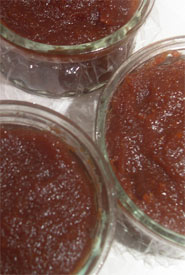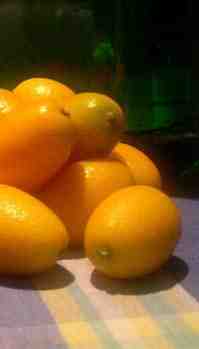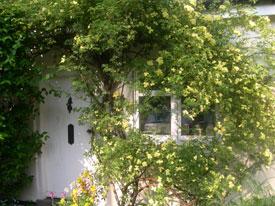Easy quince cheese recipe (membrillo)
Posted by Fiona Nevile in Fruit, Jam Jelly and Preserves, Vegetarian | 156 comments I’m back at the helm and it’s marvellous to be feeling well and chirpy and slimmer. Forget Champneys. A week in bed with a bug does wonders for the figure.
I’m back at the helm and it’s marvellous to be feeling well and chirpy and slimmer. Forget Champneys. A week in bed with a bug does wonders for the figure.
Danny put on his sensible parent hat this morning. He instructed me not to go to work, reasoning that more recuperation was required. He was right. I did feel weak.
This afternoon, he relented slightly.
“Why not go out foraging for an hour. You could do with some fresh air.”
He passed me the foraging stick, tossed me his car keys and disappeared upstairs.
I found some plump sloes and with the help of the walking stick accessed branches that only a seven foot giant could reach. The crab apple tree had a small final harvest. Being north facing its fruit had not spoiled. I tootled home and simmered the crab apples with chillies to make a hot jelly (recipe later this week if it turns out well).
My main aim today was to make some quince cheese. The quinces had been cooked and strained for jelly the week before last. The juice and flesh keep well in the fridge for up to two weeks. Today was the last day.
When I discovered membrillo at the Spanish Deli in Portobello Road I was delighted. I love the combination of membrillo and Manchego. Danny wasn’t impressed. His face crumpled when he tasted it.
“It’s so sweet. How can you like it?”
I was pretty sure that membrillo needn’t be so sweet. I looked at various recipes on the internet. The amount of sugar varied enormously. In the end I decided to plump for an equal volume of quince pulp to sugar. This has produced a membrillo that is sweet but tastes of quince. I reckon that one could get away with even less sugar in fact when I looked in my copy of Oded Schwartz, his recipe uses slightly less – 50g less. Adding the lemon juice made a difference too.
They key to this recipe is time. I simmered the quinces for at least three hours until they became a deep pink colour. The final stage is a long process too. The quince pulp and sugar was simmered gently (lowest setting) for a good 2-3 hours to intensify the colour and thicken the pulp to the right consistency. There is no need to bring the mixture to a rolling boil. This is a recipe that is spread over two evenings. One evening simmer the quinces and strain overnight. The next evening make the membrillo.
Danny tasted it gave the recipe the thumbs up, especially when he realised that the by product is the juice for quince jelly.
Easy quince cheese recipe (membrillo)
Ingredients:
For the quince pulp:
- 1 kilo of quinces
- Zest of half a lemon
- Water to cover
For the quince cheese:
- Quince pulp
- Juice of half a lemon
- Granulated (not castor) white sugar (equal volume to the pulp)
Method:
- Rub the down off the quinces and wash them. There is no need to peel or core the quinces.
- Chop the quinces carefully, as they are hard it is easy for the knife to slip. I chopped them into quarters and sliced them into 1cm slices.
- Place the quince slices in a large saucepan or casserole dish and add water so that they are just floating. Add the zest of half a lemon.
- Bring slowly to the boil and then turn the hob down to it’s lowest setting so that the quinces gently simmer (lid on). Simmer the fruit until very soft and the fruit has turned a deep pink colour. This took me about 3 hours. Check the quinces every now and then and top up the water if necessary.
- Strain the juice from the fruit overnight using a jelly bag or muslin square. Retain the juice to make quince jelly.
- I was loathe to spend hours pressing the quinces through a sieve so I put them through the Magimix
(medium grater blade) and then I sieved them.
- Measure the pulp using a measuring jug put the pulp into a large heavy bottomed saucepan or casserole dish and add an equal volume of white granulated sugar. Add the juice of half a lemon.
- Bring the pulp and sugar gradually to simmering point, stirring to dissolve the sugar and let it simmer, lowest setting for 2-3 hours, stirring every now and then to stop it sticking and burning. It will resemble gloopy mud. Gradually the colour will darken. Eventually the fruit will become very thick (I could stand my spoon up in mine).
- Spoon into well oiled sterilised straight sided jars and seal with cellophane lids. This will keep for months. Cut slices to eat with cheese or cold meat. Refrigerate after opening.
Leave a reply







Hi Claire, I too have fallen in love with quince fruit!
My second batch of Membrillo was a bit soft and squishy compared to my first attempt, so the next time I made it I simmered the pulp (after it had been through a fine sieve) for an hour without the sugar thus reducing it down a bit. I measured the pulp first and for every pint I added one pound of sugar (this is UK measurements) or as Fi says above, add equal volume of sugar to pulp. Then I simmered it WITH the sugar for almost 2 hours.
I also felt the overall texture improved if I put the cooked quince through a very fine sieve. Harder work but worth the effort!
I have a sneaky suspicion the Quince is going to be the next ‘big thing’ in the food world!
I have recently developed an obsession with quince. I tried making Membrillo, but it turned out pale pink and soft and sticky (delicious anyway, with cake or pancakes), rather than deeper red and cutable with a knife. I’m trying again today. Any idea what I should do different? I thought maybe I had the amount of sugar wrong, as the recipe I found said to use an equal weight to the quince, and in America we don’t really have kitchen scales. I’m going to try equal by volume today, and let each stage go for a while longer.
I asked all the grocery stores near here for quince, and they all ordered them–now there are piles of quince in all the stores, and they’re expensive. I hope someone else discovers them when they walk by and the fragrance arrests them.
I cut out the good bits of quinces with brown inside and reject the brown bits. The brown is rot and is often cause by the quince splitting and rotting back from the split (the result of not enough water). Hope that this helps.
I am in the process of making the membrillo, I have hundreds of quinces in my garden. I have noticed the onces that look best on the tree are not always the best when you cut into them. If contain some brown inside can they still be used. This is not brusing as they are straight off the tree, can any only help? thanks
Hi Ianthe,
Yes we do make hedgerow jelly but I haven’t been canny enough to gather the fruit over an extended period, freezing the fruit. Thanks for the tip.
Interesting that you include fuschia fruits. I have never heard of this and had no idea that they are edible.
I have started using all strained friut for fruit cheese. I use the same recipe as above. This weekend I am hoping to have the time to venture out and make fruit leather!
Hi,
Re japonica I have used them successfully in mixed jellies: crabapple and jajponica v good. Also used in my favourite hedgerow jelly. Do you make it? Varies every year depending on the fruit available.
I start earlier picking the elderberries and freezing them. Pick and freeze a mixture until the sloes and later fruits are ready. Any year can include the following: crabapples, blackberries, sloes, haws, rosehips, fuschia fruits, rowan berries, whitebeam berries, ornamental crabs, berberis (must be ripe berberis), windfall apples, elderberries, japonica juice of 1 or 2 lemons (optional). Usual jelly recipe. just cover with water & simmer till soft. Strain thru jelly bag etc overnight. 1lb sugar to each pint of juice. add knob of butter to jelly as boiling to get rid of any scum.
Does anyone else make this & do you use the left overs for fruit cheese? If so is it the same method as for making quince cheese?
Ianthe
Hi Seahorse,
Bad luck.
I am sure that the tart tatin will be delicious. My favourite.
Hmm yes. Crab apples. I actually unwittingly bought some small egremont russet. Completely different. Oh well, tarte tatin it is then
Could be the Egremont Russets were unripe, just needed a bit more time. I recently bought some greengages and apricots from the supermarket; they were solid. I had to wait about 2 weeks after their best before for them to reach lusciousness, ignoring the pack instructions which were to store in the fridge.
Hi Robin,
Thanks for the tip. Interesting that glycerine worked for the jars.
Hi Seahorse,
Glad that the quince jelly worked for you.
The japonica quinces can be used now (hard) the resulting jelly will be almost the same.
Good luck with the crab apples.
Hi, thanks for the feedback. I’m so in love with quinces at the moment. Re volume – I could have added a bit more water at the start in retrospect, though the juice I got from the quinces just looked so thick and pink and gorgeous I held back the temptation to dilute it. Will be having another go. It’s such a pretty jelly. Got some little ornamental ones from a neighbour’s garden. I know they will be more sour but it’s worth a try just to experiment. Need them to ripen up first but it’s all happening at this end. Crab apples next.